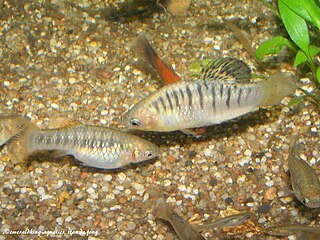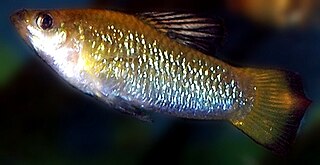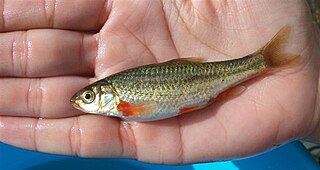
Mackerel is a common name applied to a number of different species of pelagic fish, mostly from the family Scombridae. They are found in both temperate and tropical seas, mostly living along the coast or offshore in the oceanic environment.

Herring are various species of forage fish, belonging to the order Clupeiformes.

Sardine and pilchard are common names for various species of small, oily forage fish in the herring suborder Clupeoidei. The term 'sardine' was first used in English during the early 15th century; a somewhat dubious etymology says it comes from the Italian island of Sardinia, around which sardines were once supposedly abundant.

Poecilia is a genus of fishes in the family Poeciliidae of the order Cyprinodontiformes. These livebearers are native to fresh, brackish and salt water in the Americas, and some species in the genus are euryhaline. A few have adapted to living in waters that contain high levels of toxic hydrogen sulfide and a population of P. mexicana lives in caves.

The Atlantic salmon is a species of ray-finned fish in the family Salmonidae. It is the third largest of the Salmonidae, behind Siberian taimen and Pacific Chinook salmon, growing up to a meter in length. Atlantic salmon are found in the northern Atlantic Ocean and in rivers that flow into it. Most populations are anadromous, hatching in streams and rivers but moving out to sea as they grow where they mature, after which the adults seasonally move upstream again to spawn.

The warmouth is a freshwater fish of the sunfish family (Centrarchidae) that is found throughout the eastern United States. Other local names include molly, redeye, goggle-eye, red-eyed bream, and strawberry perch.

The European river lamprey, also known as the river lamprey or lampern, is a species of freshwater lamprey.

Limia is a genus of livebearing fishes belonging to the Cyprinodontiform family Poeciliidae. It comprises 22 described species found in fresh, brackish, saltwater, and hypersaline habitats of the Greater Antilles islands in the Caribbean Sea. A vast majority are endemic to Hispaniola. There has been a long-running debate on whether Limia should be considered a subgenus of Poecilia rather than a full genus. Most Limia species are detrivores and herbivores. Due to their small size and coloring, they are sometimes kept in home aquaria.

The humpbacked limia or black-barred limia is a critically endangered species of poeciliid fish which is endemic to Haiti. Its common name is derived from the hump males develop as they age. It is sometimes kept in home aquaria.

The northern red-legged frog is a species of amphibian whose range is the coastal region stretching from southwest British Columbia to southern Mendocino County in Northern California, and is protected in Oregon and California. As a member of the genus Rana, this species is considered a true frog, with characteristic smooth skin and a narrow waist. This frog requires still waters for breeding, and is rarely found at any great distance from its breeding ponds or marshes.

Perugia's limia is a poeciliid fish endemic to the Caribbean island of Hispaniola. It is one of the most widespread species in the Limia genus, inhabiting waters ranging from fresh to hypersaline. Unlike most Limia species, L. perugiae is omnivorous. Dominant males are especially colorful. Females give birth to live young.

Achondrostoma oligolepis is a species of cyprinid fish. It is endemic to central and northern Portugal and known from between Limia and Tornada drainages, south of Douro. It occurs in the lower stretches of rivers and streams. It can grow to 25 cm (9.8 in) total length, although it typically measures about 15 cm (5.9 in) TL.
Limia melanonotata, the blackbanded limia, is a toothcarp in the family Poeciliidae. It is endemic to the island of Hispaniola.

Limia sulphurophila, also known as sulphur limia, is a livebearing fish in the family Poeciliidae. It is endemic to the Dominican Republic in the island of Hispaniola.

Limia islai, also known as the tiger limia, is a species of fish within the family Poeciliidae. This species is one of several Limia that are endemic to Lake Miragoâne, Haiti.

Limia melanogaster, the black-bellied or blue limia, is a poeciliid fish from Jamaica. It inhabits fast-flowing streams. It is a rare livebearer in modern fishkeeping.
Limia grossidens, also called the largetooth limia, is a critically endangered poeciliid fish endemic to Haiti.
Limia fuscomaculata, also called the blotched limia, is a critically endangered poeciliid fish endemic to Haiti.

















